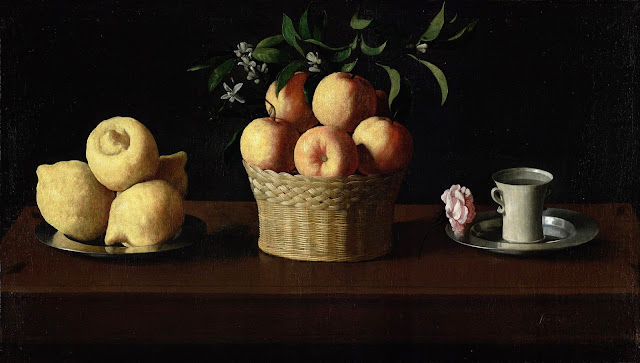 |
| Francisco de Zurbarán St Ursula ca. 1635-40 oil on canvas Musei di Strada Nuova, Genoa |
 |
| Francisco de Zurbarán St Dorothy 1640 canvas Museo de Bellas Artes de Sevilla |
 |
| Francisco de Zurbarán Infant Christ ca. 1635-40 oil on panel Pushkin Museum, Moscow |
"Francisco de Zurbarán (1598-1664) a native of the town of Fuente de Cantos and resident of the city of Seville, began his study of art in Estremadura with some disciple of the divine Morales. Afterwards, in order to perfect his art, he went to Seville to the school of Juan de las Roelas and did so well that he earned the reputation of an excellent painter by means of the many works he did. Particularly noteworthy are those by his hand in the small cloister of the Merced Calzada in said city, which show the story of St. Peter Nolasco."
 |
| Francisco de Zurbarán St Peter Nolasco recovering the image of the Virgin 1630 oil on canvas Cincinnati Art Museum |
"This artist was so studious that he used mannequins when he painted drapery and a live model for the flesh tones, following the school of Caravaggio, a painter whom he liked so much that someone seeing his works, and not knowing whose they are, will not hesitate to attribute them to Caravaggio. . . . It is a well-known story that when he returned to live in Fuente de Cantos, his birthplace, the city of Seville sent a delegation to him, asking him if he would deign to come to live in Seville to honor it with his presence and eminent skill. Since there were at that time other famous painters in the city, he agreed to go, as was befitting such an honor. It is certain that besides his talent he was a highly recommendable person because of his appearance, dress, and natural endowments. And they even say that they offered him a house . . . "
 |
| Francisco de Zurbarán St Ambrosius ca. 1626-27 oil on canvas Museo de Bellas Artes de Sevilla |
 |
| Francisco de Zurbarán St Elisabeth of Portugal ca. 1635 oil on canvas Prado, Madrid |
 |
| Francisco de Zurbarán St Casilda ca. 1630-35 oil on canvas Museo Thyssen-Bornemisza, Madrid |
| Francisco de Zurbarán Archangel Gabriel ca. 1630-31 canvas Musée Fabre, Montpellier |
"Finally he came to Madrid around the year 1650, called by Velázquez at the King's orders, where he executed the paintings of the Labors of Hercules that are in the salon in the Palace of the Buen Retiro over the large pictures. And they say that when he was painting them, Philip IV, on one of the many occasions he came to watch him work, approached him one time and, putting his hand on his shoulder, said to him, "Painter of the King and King of Painters."
– quoted passages above are from the life of the artist by Antonio Palomino de Castro (Madrid, 1724) as translated by Jonathan Brown in Italian and Spanish Art, 1600-1750 : Sources and Documents (Northwestern University Press,1992)
 |
| Francisco de Zurbarán Bodegón ca. 1650 oil on canvas Prado, Madrid |
 |
| Francisco de Zurbarán Cup of water and Rose ca. 1630 oil on canvas National Gallery, London |
 |
| Francisco de Zurbarán Still-life with lemons oranges and a rose 1633 oil on canvas Norton Simon Museum, Pasadena |
Francsico's son Juan de Zurbarán (1620-49) trained with his father in Seville. He demonstrated an inclination toward the still-life aspect of his father's practice, and seems to have avoided religious iconography. Perhaps he would have moved in additional directions if he had not died while still in his twenties during an unfortunate episode of plague at Seville.
 |
| Juan de Zurbarán Bodegón de limones 1640 oil on canvas Real Academia de Bellas Artes de San Fernando, Madrid |
 |
| Juan de Zurbarán Still-life with plate of apples and orange blossom ca. 1640 oil on canvas private collection |
 |
| Juan de Zurbarán Basket with Apples, Quinces, Pomegranates ca. 1643-45 oil on canvas Museu Nacional d'Art de Catalunya, Barcelona |